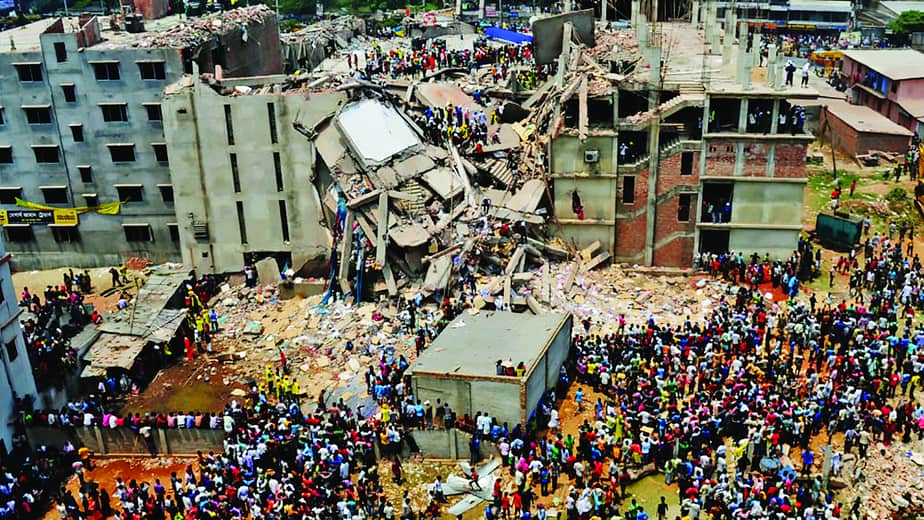‘People are not just wearing clothes, they are wearing dried blood, sweat and tears packaged in a fancy box of human misery’
Only a few sensitive souls choose to think about what goes into the making of the glamorous $3,000-billion fashion industry. Two of them are Carry Somers and Orsola de Castro. In 2013, the death of more than 1,130 garment factory workers in the Rana Plaza disaster in Bangladesh led them to initiate a conversation about the need for greater responsibility and transparency in the supply chain of the global garment industry.
Their initiative, called ‘Fashion Revolution’ has now grown into the world’s largest fashion activism movement, with teams and online presence in over 100 countries. It encourages people to ask: Who made my clothes? As global brands outsource production to developing countries like Bangladesh, Vietnam and even India, there is less clarity on the condition of workers who hand-embroidered the details you fell in love with on your Zara shirt.
Every outfit we own has reached us after a long journey passing through the hands of multiple people. Majority of the 25 lakh employees who work in the growing apparel industry in India (contributing 11 per cent to exports, and over 5 per cent to GDP) that includes tailors, embroiderers, and others, are being subject to exploitation. The issues are multiple, ranging from the unsafe working environment to indefinite working hours and low wages.
India, as a major production hub and marketplace for the apparel industry, has caught the movement with great force on social media among the conscious in the country. Wages and textile waste are the ‘spotlight issues’ for 2018, with the responsible ones actively posting selfies holding their favourite outfit showing its brand tag and a placard that says — “Who made my clothes?” The idea behind this wave is to create awareness among consumers about the said cause and to question brands about the well-being of workers who produce garments for them.
Country Head for Fashion Revolution in India, Suki Dosanj is a part of this initiative with the fast-growing tribe working tirelessly to create as much buzz as possible for a fair, safe, and more transparent fashion industry. She agrees that social media is the easiest, most direct way for a conversation to take place between suppliers and consumers of fashion, but she looks forward to the day when these conversations will influence behavioural change. According to her, there is still a whole lot of crucial information about the practices of the fashion industry that remain concealed, particularly when it comes to brands’ tangible impact on the lives of workers in the supply chain.
Not just that, she also believes we need to educate ourselves about the detrimental effects of our buying habits on the environment and how fast fashion waste is adding up to the landfill crisis. She said in an interview, “Much of the cheap polyester, nylon and rayon clothing is not decomposing” and strongly encourages people to recycle and re-use as a thing of pride. “Think before you buy. Ask yourself – do I really need it?” she adds.
Doodlage, a Delhi-based fashion label that uses textile waste from export houses to produce their clothes, has recently been speaking about the craftsmen who make the clothes, posting their pictures on social media, holding a placard that says, “I made your clothing.” NoNasties, a T-shirt company that uses 100 per cent organic cotton and Deivee, a sustainable womenswear label by Milind Soman are amongst those who joined the movement by starting a Fairtrade line. Celebs like Tisca Chopra, Kalki Koechlin, and Monica Dogra have posted about the cause on social media and fans have followed suit.
While there is enough conversation about the issue and many more enterprises have come up that call themselves fair trade organisations, it is difficult to say if these measures are enough to confirm the well-being of workers and the environment on any level. Gurleen, a recent fashion graduate, has observed the entire discussion regarding the campaign but is quick to point out if the conversation could rather have been about fashion workers’ fair wage and the environmental hazards associated with textile waste.
With the arrival of high street brands like Zara and H&M, that follow fashion cycle with a lifespan of 15 days, people are mindlessly buying more than ever and are rejecting old clothing before they even wear it.
“Most people don’t buy clothing to be responsible but because they want to look a certain way. It is a way they express “themselves”, says Jasroop Grewal, an accessory designer who thinks there is still a long way to go for people in India to understand the need to shop responsibly. However, if the advocates of clean fashion keep doing the needful, the narrative will soon start to take a positive leap.
Bloody Garments
Fashion designer Kunal Debnath shares his experience of working in the industry and how relevant is a campaign like #whomademyclothes?
Fashion Revolution is helping to create a lot of awareness by bruiting the importance of green fashion/sustainable fashion. Its effects and how we can use sustainable processes for a sustainable environment. With ‘who made my clothes’ it has really put the back end to the ultimate spotlight.

Now, at least some consumers are asking these relevant questions about the whole supply chain and the conditions of the people. How a particular product has been sourced, produced for a fair business. Some designers are also stepping forward to create more zero waste clothing, recycled clothing or just slow fashion.Especially in India, sustainable fashion has gone into a very stereotyped expression. It needs innovation. More imagination, so to say.
Whereas the working conditions of fashion workers, it is disrespectful, in a nutshell. I have myself seen the bad working condition, workers working in this scorching heat with just a single ceiling fan. Their uneducated background has helped the bourgeois to mend more and more money.
There should be sufficient amount of light to work. Safe drinking water and safety measures. There should be monthly inspections in all factories to keep a check on working and living conditions. Exploitation, abuse, harassment has always been a toxic ingredient in this industry. Companies need to understand the importance of human labour and the sensitivity behind it, rather than treating them like Japanese fast machines.
I have more and more to say but…. it’s extremely sad and disheartening. People are not just wearing clothes, they are wearing dried blood, sweat and tears packaged in a fancy box of human misery.





